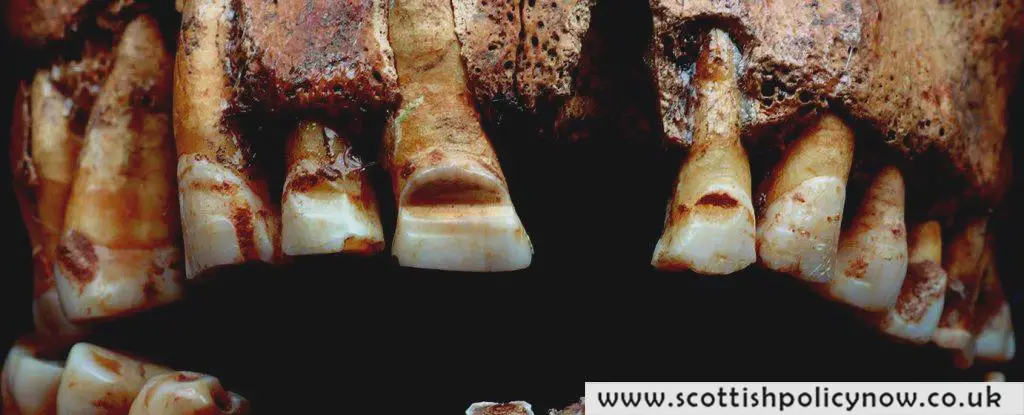Humans have altered their bodies in various ways throughout history, through tattooing, piercing, scarring, implanting, or even deforming parts of their anatomy. Despite its commonality, the reasons aren’t always clear. Cultural traditions and beauty standards, which differ across time and locations, are significant factors.
Recent analysis of remains from individuals who lived in Viking Age Gotland about a thousand years ago suggests that their body modifications reinforced social identities.
Archaeologists Matthias Toplak of the Viking Museum Haithabu and Lukas Kerk of the University of Münster in Germany discovered that horizontal grooves filed into the teeth might have been a characteristic of a group of merchant men.

Meanwhile, the only cases of intentional reshaping and elongation of the skull associated with the Viking Age were found in three Gotland women. The origin and significance of this particular modification have been challenging to determine.
“While both forms of body modification have been widely noted in other cultural contexts,” the researchers stated in their paper, “the specific expressions of these customs in Viking Age society still lack systematic study in terms of their social implications.”
Tooth and skull modifications have been practiced by various cultures for thousands of years. Vikings, known to have practiced tooth modification, are evidenced by skillfully filed horizontal grooves on the teeth of Viking Age men from what are now Sweden and Denmark, a practice that appears to have continued for centuries.
The most significant number of remains with filed teeth were found in Gotland, suggesting the practice may have originated there. This also makes the region an excellent case study for understanding the purpose behind the filed teeth. Were the Vikings simply fans of the look, or was there a deeper meaning?
Previous research suggested that bodies with filed teeth might belong to a specific group of people. Toplak and Kerk, analyzing the bones of about 130 such men, noted that the remains were found in trading areas, and all individuals with filed teeth were adult men.
Furthermore, the remains with filed teeth in one Gotland cemetery were all located in one area, many buried face down, supporting the idea that it was a burial site for non-local individuals who periodically stayed in the town.
“We thus theorize that tooth filing might have been connected to the trading activities of large groups of professional merchants,” they suggested.
“According to our theory, it may have served as a rite of initiation and a sign of identification for a closed group of merchants, akin to the precursor of later guilds.”
While it may have been a distinguishing feature of Gotland merchants, the practice was not limited to this location alone. With variations in the number of teeth filed and the lines per tooth, tooth filing could have served different purposes across parts of Viking Age Sweden and Denmark.
As for the three women with skull modifications, the grave of one contained few goods, but the other two were buried with the rich jewelry and clothing typical of Gotland burials, indicating they were valued members of their communities.
Although skull modification has not previously been linked with cultures in this region, DNA analysis showed one of the women was from Gotland and another from the Baltic region, indicating the practice cannot be confidently attributed to areas outside Gotland, as seen in other cemeteries.
It’s possible the Gotland woman was born elsewhere to Gotlandish parents, underwent skull binding in early childhood, and then returned to Gotland. In any case, all three women appear connected. They lived around the same time, and the same method was used to shape their skulls.
Since their body modifications were not widely adopted by the Viking communities in which they lived, the researchers believe these practices had limited local significance and were likely performed elsewhere.
Tooth filing and skull shaping represent two distinct approaches to body modification in Viking Age Gotland, the researchers explain.
“The society of Viking Age Gotland used tooth filings as an internal sign system in their social communication. As a conscious choice by adults, predominantly male, we argue that tooth filings were primarily meant for endogenous interpersonal communication—members of a certain social group could recognize each other,” they wrote.
“Skull modification, on the other hand, was imposed on the three females during their earliest childhood to signify their affiliation to a specific social group. This too was a form of endogenous interpersonal communication, though within a larger cultural group. On Gotland, however, this sign was likely unknown to the broader society.”
It’s challenging to definitively determine the functions of body modification practiced by our ancestors. However, by viewing it through the lens of communication and community, we begin to understand its possible meanings.
The team’s research has been published in Current Swedish Archaeology.








